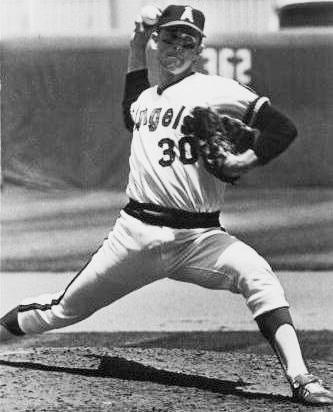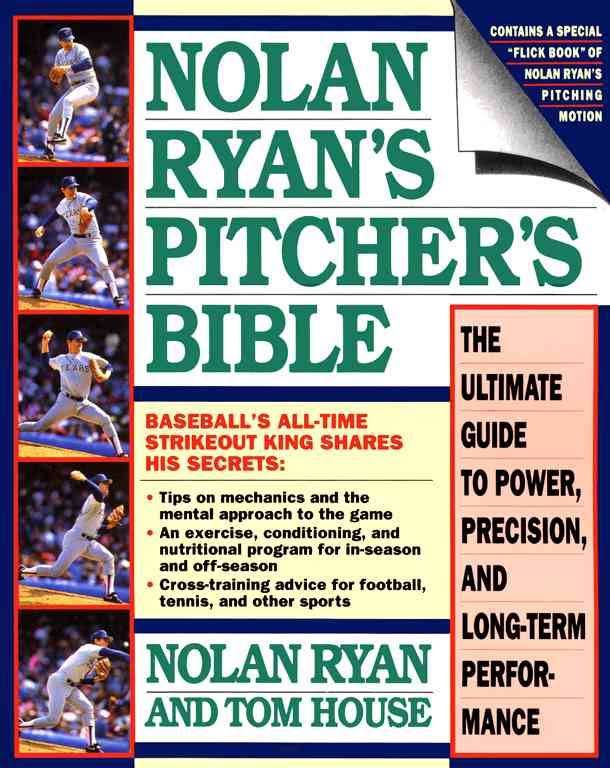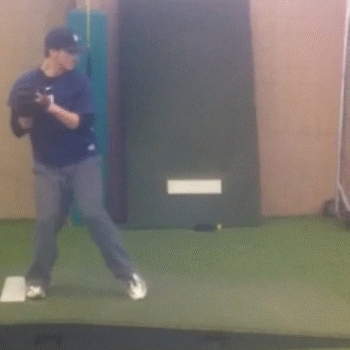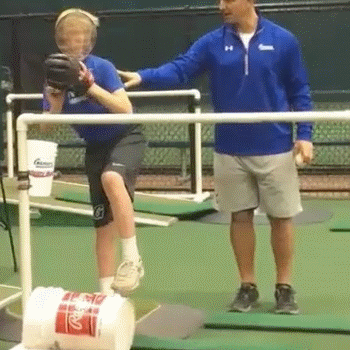Nolan Ryan threw harder than Mark Prior ever did.
And for far longer.
Some would say that was because Nolan Ryan was a genetic freak and stop reading then and there.

Nolan Ryan and Mark Prior
However, when I look at clips of Nolan Ryan and Mark Prior, compare their pitching mechanics and how they move on a frame by frame basis, and look at the similarities and differences, I see two very different pitchers. Similarly, when I dig into what Nolan Ryan and Mark Prior were taught and how, I find two completely different approaches to teaching pitchers and developing pitching mechanics.
Maybe those differences are inconsequential. Maybe there's nothing to be learned by studying the differences between pitchers like Nolan Ryan who were dominant and durable and pitchers like Mark Prior who weren't.
But this book is my bet that there is.
This Isn't Just Business, It's Personal
 How do you teach pitchers to move like Nolan Ryan and not like Mark Prior?
How do you teach pitchers to move like Nolan Ryan and not like Mark Prior?
More generally, and more importantly, how do you develop pitchers who are both dominant and durable like Nolan Ryan was?
Those aren't just theoretical questions for me.
I have a son in high school and one of the things he does, and does well, is pitch.
The problem is that, while he is more effective, statistically speaking, than many pitchers his age, his velocity is at best middle of the pack. That doesn't matter when it comes to effectiveness; four pitches with command and movement beat harder but flat fastballs down the middle every day. However, as with many high school baseball programs, that seems to have very little influence on some of his coaches.
Simply put, in their eyes you need raw velocity to first get on the team and then to get a chance on the mound.
However, velocity isn't worth much if you can't stay healthy, and my son missed most of his 7th grade baseball season due to our trying to getting him started with a wood bat and learning how to load like Buster Posey does when his body wasn't ready for it and perhaps was in the middle of a growth spurt.
As a result, while I'm constantly thinking about ways to boost my son's velocity by 5 or 10 miles per hour, I'm always nervous about over-doing it and reliving his miserable, frustrating, and largely baseball-less 7th grade baseball season.
 Nolan Ryan's Pitchers Bible
Nolan Ryan's Pitchers Bible
Literally the first book I bought in 2004 or 2005 when my boys started to get older and I started trying to educate myself about pitching and pitching mechanics was Nolan Ryan's Pitcher's Bible.
As a child of the 70s and 80s, I was very familiar with Nolan Ryan, given that I live in St. Louis and Nolan Ryan pitched for the Astros. I was also an obsessive watcher of This Week In Baseball, and Nolan Ryan seemed to put up a highlight-worthy performance pretty much every week.
I bought Nolan Ryan's Pitcher's Bible with the hope of learning how Nolan Ryan did what he did and got where he did.
While the conditioning information was and remains quite good, and still makes the book worth buying, when it came to pitching mechanics -- and by Nolan Ryan's own admission in several places in Nolan Ryan's Pitcher's Bible -- what I primarily got were Tom House's ideas about how pitchers should move.
Not a detailed description of how Nolan Ryan actually moved.
In fact, I was familiar enough with Nolan Ryan's delivery from watching him on TV that I knew that what I was reading, and what Nolan Ryan did, were two different things. As a result, I returned the book to its spot in my library and set out to find out whether people like Tom House knew what they were talking about and, more importantly, whether they were selling theory as fact. In sum, what I found was that much of what I was read about in Nolan Ryan's Pitcher's Bible, at least when it came to pitching mechanics, were Tom House's theories about proper pitching mechanics.
Theories he would try out on Mark Prior just a few years later.
I've discussed my research into Mark Prior's pitching mechanics, the Inverted W, the problem with Timing problems, and the root causes of the pitcher injury and Tommy John surgery epidemic elsewhere, so I'm not going to get deep into the injury thing here. What I haven't discussed, or realized, until recently are how so many of those problems are tied into the quest for velocity and how I believe the current view that dominance and durability are trade-offs is a false choice.
As a Jesuit-Educated Missourian...
It's clear to me that many of Tom House's absolutes aren't based on a study of how Nolan Ryan actually moved.
I mean, even as a kid, and with the naked eye and a crappy old 70s-era TV, I could tell that Nolan Ryan wasn't staying tall and just falling down the mound. Instead, and very much like Tom Seaver, in his prime Nolan Ryan was dropping down and driving forward toward the plate.
So where did the disconnect come from?
How and why did Tom House end up writing a book about Nolan Ryan that, at least in terms of Nolan Ryan's pitching mechanics, in the best case ignored what Nolan Ryan did and in the worst case taught pitchers to do the opposite?
I don't know for sure, but I have a number of theories.
I think part of the problem was that Tom House was (and is) trying to come up with a single set of pitching mechanics that he could teach to every pitcher. The problem is that there are two types of pitchers; athletes and non-athletes. While Tom House's theories may enable all pitchers to throw strikes, in my opinion and experience they force athletic pitchers, who want to throw hard, into a problematic movement pattern.
In my experience, and based on the video I have looked at, pitchers who follow Tom House's absolutes and who want to throw hard are typically forced into a problematic movement pattern; they virtually have to develop an inverted arm action, and often and worse yet a Timing problem, in order to reach their velocity targets.
The other issue, which continues to this day, is that I think Tom House forgot he was dealing with human beings.
As Tom House once said about Mark Prior, "Because he was a computerized athlete, he was supposed to be perfect." While I have some doubts about whether Tom House's mechanical model is as optimized as he thinks it is -- remember, Nolan Ryan threw harder than Mark Prior ever did -- that quote reflects Tom House's mindset; he's trying to optimize for both velocity and durability.
However, I think Mark Prior's career demonstrates that isn't the case.
As I discuss at length in Tom House: The Solution or The Problem, the present problem is that Tom House isn't trying to change his approach to developing pitchers or build a better mechanical model. Instead, given his current heavy emphasis on conditioning, he seems to be trying to build better humans; humans who can tolerate his theoretically perfect pitching mechanics.
Inverted W Redux
My investigations into Tom House's history are driven by my interactions with pitchers who have been trained according to his principles. You can't troubleshoot a system if you don't first understand why it is the way it is. As a result, I've spent years trying to figure out why House-trained and influences pitchers move the way they do.
The picture started to come into focus in 2012 when I was contacted by a pro pitcher who wasn't taught the Inverted W but who demonstrated it nonetheless.

2012 Inadvertent Inverted W
As I explained to the Illinois High School Baseball Coaches Association in early 2013, I came to believe that this pitcher's Inverted W was the result of what he had been taught, not about his arm action, but other aspects of his delivery.
Then, in early 2015, I came across a video that showed a young pitcher who made the Inverted W.

2015 Inadvertent Inverted W
Again, when I talked to his pitching coach, he told me he knew the Inverted W was problematic, didn't like it, didn't teach it, and was disturbed by what he saw in the video.
So what was causing pitching coaches to produce, and pitchers to develop, an arm action that increasing numbers of people believed was problematic?
Why?
There are two reasons why the Inverted W is popping up again.
First, we are seeing more and more Inverted Ws because the positions, cues, and drills that led Mark Prior to develop his Inverted W are still, and in many cases increasingly, being taught.
Second, an active disinformation campaign is underway by the quickie pitching velocity boost industry to make people believe the Inverted W, the other inverted arm actions, and the other things that create Timing problems are safe, despite emerging evidence to the contrary. For reasons I don't completely understand, Jeff Passan has decided to join the side of the deniers -- playing a role that brings to mind The Tobacco Institute in the 1980s -- which leaves me dreading the release of his upcoming book The Arm.
Dominant & Durable
And how does Dominant & Durable fit into the picture?
It does three things...
- It explains the movement patterns that dominant and durable pitchers like Nolan Ryan, Tom Seaver, Mariano Rivera, and David Price employ.
- Using Justin Verlander as an example, it discusses the cues and drills that in the best case inhibit those dominant and durable movement patterns and in the worst case force pitchers to develop problematic movement patterns.
- It explains how to teach the dominant and durable movement patterns.
Again, I believe that many people think I am taking a risk; that the only way he will be able to compete with the problematic pitching mechanics pitchers is to follow their lead. However, I believe the history of the game, and the stories of...
- Nolan Ryan
- Tom Seaver
- Mariano Rivera
- David Price
- Justin Verlander
...and many other pitchers suggests that there is another path.
A path that doesn't treat dominance and durability as irreconcilable. A path that produces major league starting pitchers who are both dominant and durable. A path I'd love to share with you.
Join Me
To get on the path to developing pitchers who are both dominant and durable you need to become a client and purchase one of my two products that provides access to Dominant & Durable...